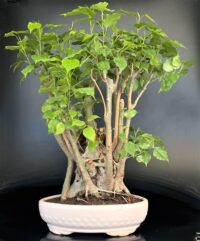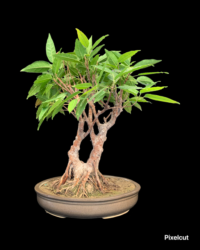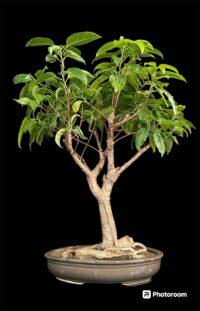The Ultimate Guide To Ficus Microcarpa Bonsai: Tips & Tricks
The Ultimate Guide To Ficus Microcarpa Bonsai: Tips & Tricks
If you’re a plant lover and want to add a touch of greenery to your home, a Ficus Microcarpa bonsai could be the perfect choice. This popular houseplant is known for its easy maintenance and stunning aesthetics. However, keeping a Microcarpa bonsai healthy and looking its best requires proper care and attention. In this ultimate guide, we will provide you with tips and tricks to help you care for your Microcarpa bonsai.
F, Microcarpa is a very confusing name as told by many nursery people and vendors, its become a kind of generic name for many unknown ficus varieties imported cheaply from China. To be honest Retusa, Panda, Benjamina, Australian Ficus, ficus black or even Ficus compact etc can also be called Microcarpa.
(courtesy:-Wikipedia image)
But here we are talking about specifically the plant variety which looks like the pics given above. it is widely cultivated and very appropriate for bonsai making.

Introduction
Ficus Microcarpa, commonly known as Chinese Banyan or Indian Laurel, is a species of evergreen tree native to Southeast Asia, including China, Malaysia, and Taiwan. The plant is a member of the fig family and is commonly used in bonsai gardening due to its small leaves and ease of training. Ficus microcarpa was widely distributed as an ornamental plant and is one of the most common street trees in warm climates. Outside its original range.
The species has been introduced to North Africa, Iraq, Pakistan, Japan and Hawaii. In America, it was introduced in Florida and Central America and the South, where it is commonly grown as an ornamental species. In China, large fig trees can be associated with beneficial spirits and vital energy (“Qi“). In Singapore, some trees are associated with places of worship among Buddhists and Taoists.
Ficus Microcarpa bonsai is an excellent choice for both novice and experienced bonsai growers.
Benefits of Ficus Microcarpa Bonsai
Before we dive into the care tips, let’s talk about the benefits of having a Microcarpa bonsai in your home:
- Adds a touch of nature to your Home, office, conference rooms, reception and indoor space.
- Can help purify the air in your home.
- Promotes relaxation and reduces stress levels.
- Enhances the aesthetic value of your home.
Now that you know the benefits let’s get started on the care tips.
Selecting the Right Pot
The first step in caring for your Microcarpa bonsai is selecting the right pot. A bonsai pot should be proportionate to the size of the tree, allowing for proper drainage and root development. When selecting a pot, make sure it has drainage holes to prevent waterlogging and root rot.
Choosing the Right Soil
Choosing the right soil is equally important in caring for your Microcarpa bonsai. The soil should be well-draining, good textured and provide adequate nutrients and aeration. Avoid using regular potting soil, which can retain too much moisture and cause root rot. A good bonsai soil mix should contain a blend of organic and inorganic materials, such as peat moss, sand, and perlite.
Watering the Bonsai
Watering is a critical aspect of caring for your Microcarpa bonsai. Overwatering or underwatering can lead to root rot or dehydration, respectively in all the Ficus plant species. A good rule of thumb is to water the plant when the soil feels slightly dry to the touch. Make sure to water the plant thoroughly, allowing the water to drain out of the pot’s bottom.
Light and Temperature
Microcarpa bonsai thrives in bright, indirect light. Direct sunlight can scorch the leaves, while too little light can stunt growth. Place the plant near a window sill, patio, balcony or garden that receives bright, filtered light. The ideal temperature range for Microcarpa bonsai is between 60-75°F (15-23°C). Avoid exposing the plant to sudden temperature changes, such as drafts from open windows or doors.
Fertilizing
Fertilizing is essential in providing your Ficus Microcarpa bonsai with the necessary nutrients for healthy growth. Use a balanced fertilizer, such as 10-10-10, during the growing season (spring and summer). No fertilization should be done during the dormant season (fall and winter). Avoid over-fertilizing, which can lead to salt buildup and damage the roots.
Pruning and Training
Pruning and training are crucial in maintaining the shape and size of your Microcarpa bonsai. Regular pruning helps stimulate new growth and removes dead or damaged branches. Training involves shaping the tree’s trunk and branches through wiring or clipping. Be careful not to over-prune or train the tree, as this can weaken it and stunt its growth.
Repotting of Bonsai
Repotting your Ficus Microcarpa bonsai is necessary every two to three years. This allows for root pruning and refreshes the soil, providing the plant with fresh nutrients. When repotting, make sure to remove any dead or damaged roots and trim back healthy roots by about one-third. Try to shift with the help and use a bonsai soil mix and a pot that is slightly larger than the previous one.
Pest and Disease Control
Ficus Microcarpa bonsai is susceptible to pests and diseases, such as spider mites, scale insects, and leaf spots. Regularly inspect your plant for signs of infestation or disease and take immediate action. Use an insecticidal soap or neem oil to control pests, and remove any affected leaves or branches to prevent the spread of disease.
Frequently Asked Questions
- How often should I water my Microcarpa bonsai?
- Water your bonsai when the soil feels slightly dry to the touch.
- Can I place my Microcarpa bonsai in direct sunlight?
- No, direct sunlight can scorch the leaves. Place the plant in bright, indirect light.
- How often should I fertilize my Microcarpa bonsai?
- Use a balanced fertilizer, such as 10-10-10, during the growing season (spring and summer). Reduce fertilization during the dormant season (fall and winter).
- How do I prune my Microcarpa bonsai?
- Prune regularly to stimulate new growth and remove dead or damaged branches. Be careful not to over-prune, as this can weaken the tree.
- How often should I repot my Microcarpa bonsai?
- Repot your bonsai every two to three years to refresh the soil and prune the roots.
- How do I control pests and diseases on my Microcarpa bonsai?
- Inspect your plant regularly for signs of infestation or disease and take immediate action. Use an insecticidal soap or neem oil to control pests and remove any affected leaves or branches.
Conclusion
A Microcarpa bonsai is an excellent addition to any indoor garden. With proper care and attention, it can provide years of beauty and enjoyment. Remember to select the right pot and soil, water and fertilize regularly, prune and train the tree, and control pests and diseases. By following these tips and tricks, you can keep your Ficus Microcarpa bonsai healthy and thriving for years to come.
So, what are you waiting for? Get your hands on a Ficus Microcarpa bonsai and start your bonsai journey today!
Featured Plants
Ficus Microcarpa Bonsai
Our Motto
What you see is what you get
Delivery
Personalised delivery at door step
Mission
Creating green spaces






